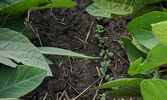Issues derived from poor soil health compound with each other, deteriorating the soil's quality at an exponential rate. In southern Alberta, we are familiar with threats like wind erosion, salinization, and soil compaction.
After each growing season, the removal of crops leaves surface soil bare and destroys soil structure as the plant is ripped from the ground. Without protection, the vital nutrients found in the top layers of soil are gone with the wind.
Cover crops offer numerous benefits to our fields. Not only do they protect soil from threats of erosion, they also support biodiversity, counter soil compaction, and restore nutrients lost throughout the growing season back to the soil.
Their canopies can provide the topsoil with vegetative cover, trapping moisture and naturally discourage weed growth. Additionally, their roots restore the carbon lost from plowing by feeding the organisms in the soil. Some cover crops, like forage radish, have long taproots to penetrate stratified soil and reconnect it to the surface.
With so many options, it can be difficult to know which cover crop is right for your operation. In our next entry of this series, we will explore specific cover crops and the benefit they bring to your operation.

